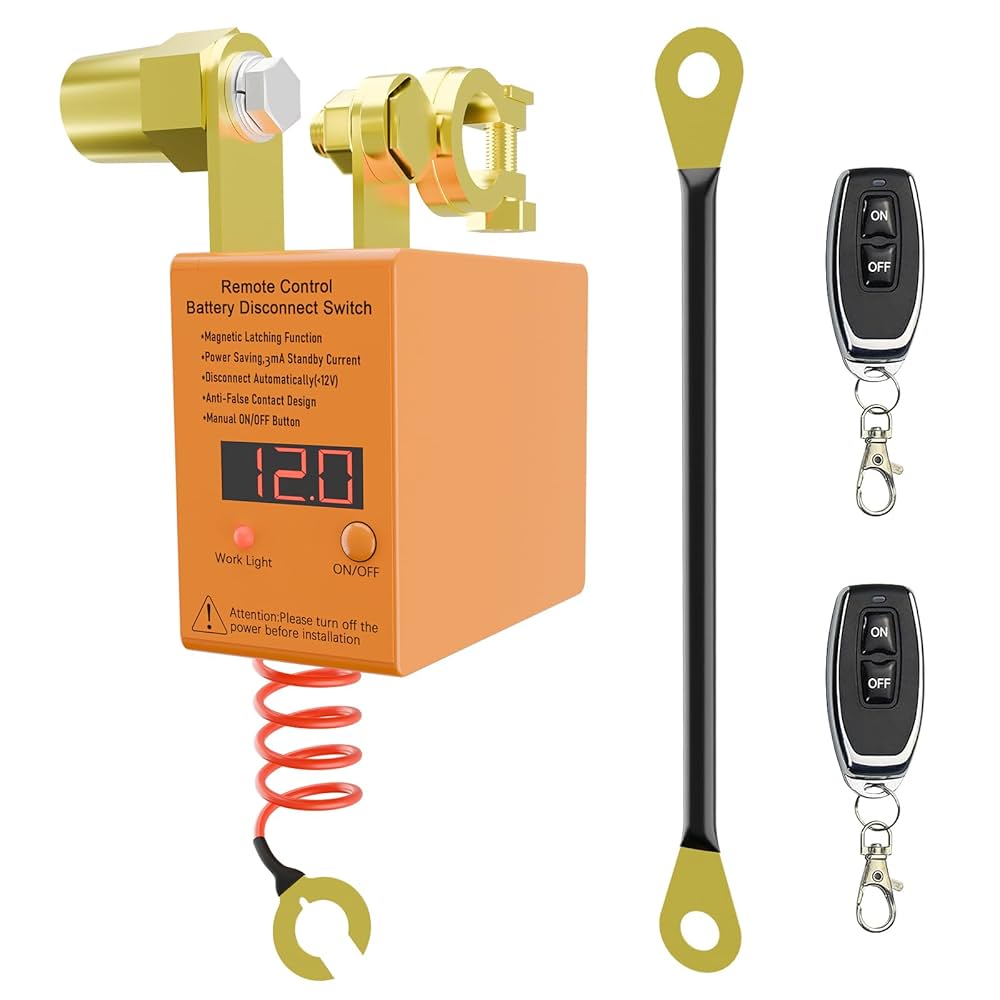Have you ever noticed that little anti-theft light blinking on your dashboard and wondered if it’s quietly draining your car’s battery? You’re not alone.
That steady blink might seem harmless, but when your car sits unused for days, you might start asking: “Is this light slowly killing my battery? ” Understanding how your anti-theft system interacts with your battery can save you from unexpected dead starts and costly replacements.
You’ll discover the truth about anti-theft lights, why they blink, and whether they really drain your battery—and more importantly, how you can protect your car’s power so it’s ready to go when you are. Keep reading to get the answers you need and avoid the frustration of a dead battery.
Anti-theft Light Basics
Understanding the basics of an anti-theft light helps car owners know its function and behavior. This small light signals the status of your vehicle’s security system. It works silently to protect your car from theft by alerting you and potential thieves.
Knowing why the light blinks or stays on can prevent confusion and concerns about your battery. Let’s explore what this light does and what its blinking means.
Purpose Of The Light
The anti-theft light shows the status of your car’s security system. It tells if the system is active or not. When the light is on or blinking, it means the car is protected against unauthorized use. This helps stop thieves from starting your engine without the key.
The light also acts as a warning to you. It lets you know if the security system is working correctly. If the light stays off or behaves oddly, it might mean a problem with the system or the car’s battery.
When It Blinks
The blinking of the anti-theft light means the system is active and ready. It usually blinks when the car is off and the key is removed. This blinking signals the immobilizer is working to prevent the engine from starting.
The blink pattern can also show if the system has detected a problem. If the light blinks faster or stays on, it might drain the battery over time. This is because the security system draws power even when the car is off.
Understanding these signals helps you keep the battery healthy and your car safe.
Battery Drain Causes
Battery drain occurs when a vehicle’s electrical system uses power even with the engine off. This unwanted power use can leave the battery weak or dead. Understanding the causes helps prevent unexpected battery failures. Common reasons vary from hidden electrical draws to simple mistakes by the car owner.
Parasitic Drain Explained
Parasitic drain happens when some car parts keep using power after the engine stops. Systems like alarm lights or control modules may stay active. This slow power loss can drain the battery overnight or over several days. Some drains are normal, but excessive ones need attention.
Common Electrical Draws
Several electrical components cause battery drain. Interior lights left on, trunk lights, or glove box lamps can stay lit by accident. Faulty relays or switches may also cause power to flow continuously. Aftermarket devices like alarms or remote starters add to the electrical load, risking faster battery drain.
Human Errors
Simple mistakes often cause battery problems. Leaving headlights, dome lights, or accessories on is common. Forgetting to close doors properly can keep interior lights on. Using electronics without the engine running drains power quickly. Regular checks help avoid these errors and save battery life.
Impact Of Anti-theft Light On Battery
The anti-theft light is a small but important feature in many vehicles. It signals that the security system is active and helps prevent theft. This light usually blinks when the car is off and the key is removed. Some car owners worry if this blinking light drains the battery. Understanding its impact on the battery helps in managing vehicle power better.
Power Consumption Levels
The anti-theft light uses very little power. It is designed to consume minimal electricity. Usually, it draws just a few milliamps of current. This low power use is intentional to keep the battery from draining quickly. The light’s blinking pattern is slow, which helps reduce energy use further.
Duration Of Drain
The light stays on as long as the car is parked and locked. This means it can draw power for hours or days. Despite this, the drain is slow and small. A healthy battery can handle this drain without problems. Issues arise only if the battery is old or weak, or if other electrical drains exist.
Comparison To Other Components
The anti-theft light uses far less power than other systems. Interior lights, radios, and alarms often consume more electricity. Faulty components or stuck relays cause higher battery drain than the anti-theft light. Thus, it rarely causes battery failure on its own. Checking other electrical parts helps find the true cause of battery drain.

Credit: www.amazon.com
Diagnosing Battery Drain
Diagnosing battery drain is essential to keep your car running smoothly. A drained battery can leave you stranded. Identifying the exact cause helps fix the problem quickly. Several steps can pinpoint why your battery loses power. Understanding these steps saves time and money.
Checking For Parasitic Draw
Parasitic draw happens when an electrical device uses power after the car is off. Start by turning off all accessories and lights. Use a multimeter to measure current from the battery. A reading above 50 milliamps may indicate a problem. Check devices like the anti-theft light, alarm, or stereo. These parts often cause hidden drains.
Testing Battery Health
Battery health impacts how well it holds a charge. Test the battery with a voltmeter or a battery tester. Healthy batteries show about 12.6 volts when the car is off. Lower readings suggest the battery is weak or failing. Replace old or damaged batteries to avoid frequent drains. Regular battery checks help prevent unexpected failures.
Inspecting Wiring And Connections
Faulty wiring or loose connections can cause battery drain. Inspect battery terminals for corrosion or looseness. Clean terminals with a wire brush if needed. Check wiring harnesses for damage or wear. Poor connections disrupt charging and increase power loss. Secure all connections tightly to ensure proper function.
Preventing Battery Drain
Preventing battery drain is important to keep your vehicle reliable. Anti-theft lights can cause a small power drain. This drain may weaken the battery over time. Taking simple steps helps avoid battery issues. These methods save your battery life and keep your car ready.
Turning Off The Light
Some anti-theft lights stay on or blink after the car is off. This uses battery power slowly. Check your vehicle settings to turn the light off if possible. A manual switch or setting in the car menu may stop the light. Turning off the light reduces constant power use.
Installing Kill Switches Or Relays
A kill switch cuts power to the anti-theft light when the car is parked. It stops the light from drawing power. Relays can also control current flow to the light. These devices prevent battery drain by disconnecting power. Installation may require a mechanic or electrician.
Using Battery Maintainers
Battery maintainers keep your battery charged during long periods of inactivity. They supply a small, steady charge to the battery. This prevents the battery from draining due to anti-theft lights or other small draws. Using a maintainer is ideal for cars stored for weeks or months.

Credit: www.amazon.com
When To Seek Professional Help
Knowing when to seek professional help for an anti-theft light draining your battery is important. Some issues are simple, but others need expert care. Early action can prevent bigger problems and save your battery.
Persistent Battery Issues
If your battery keeps dying despite charging, it needs attention. Continuous drainage might mean the anti-theft system or another part is faulty. A professional can test the battery and electrical system accurately. They find hidden problems that cause ongoing battery loss.
Complex Electrical Problems
Modern cars have complex electrical systems. Problems with wiring, relays, or modules can cause battery drain. Diagnosing these issues needs special tools and skills. A technician can trace the exact cause and fix it safely. This reduces risks and ensures the anti-theft system works properly.

Credit: carspecialistcustoms.co.uk
Frequently Asked Questions
Is The Anti-theft Light Supposed To Blink When The Car Is Off?
Yes, the anti-theft light blinks when the car is off. This indicates the immobilizer system is active, preventing theft.
What Drains A Car Battery When The Car Is Off?
A car battery drains when off due to parasitic draw from lights, faulty relays, alarms, or weak batteries. Poor connections also cause drain.
How Do I Stop My Led Lights From Draining My Battery?
Turn off LED lights when not in use. Use a timer or switch to control power. Check for wiring issues regularly.
How Do I Get My Anti-theft Light To Go Off?
Turn the ignition on and off using the correct key to reset the anti-theft system. Disconnect and reconnect the battery if needed. Consult your vehicle manual for specific reset steps.
Does The Anti-theft Light Drain The Car Battery?
The anti-theft light uses very little power and usually does not drain the battery.
Conclusion
Anti-theft lights use very little power when the car is off. Their blinking signal protects your vehicle from theft. This small drain usually does not harm your battery. Other issues like old batteries or faulty parts cause most battery drains.
Keep your battery and electrical system checked regularly. This helps avoid unexpected battery problems. Understanding your car’s systems keeps you prepared and confident. Safe driving starts with a healthy battery and secure vehicle.

















